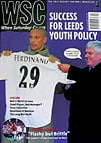 Aston Villa have demolished a famous stand. Mac McColgan wonders if its replacement will match up
Aston Villa have demolished a famous stand. Mac McColgan wonders if its replacement will match up
Could anybody argue that the Trinity Road Stand was not the finest in the history of football? Its redbrick façade, twin towers, stained glass windows, Italian mosaics and gable bearing the “Lion rampant” were the best that money could buy in 1924. Four years ago, wheels were set in motion to redevelop the stand. Various schemes were put forward for planning permission, each one rejected as the club battled with local residents and Birmingham City Council over the increased capacity and intrusion into nearby Aston Hall Park.
Villa fans were led to believe that the famous old stand was a listed building and could not be demolished, but this was untrue. However, I recall a discussion with Mark Ansell, Villa’s finance director, when he said the club would try to save as much as the old stand as possible, and that he wouldn’t be held responsible for his actions if anyone damaged one of the treasured mosaics.
Unfortunately, I failed to press him on exactly what he meant by “try” and “as much as possible”. The only part now remaining from the old stand is one of the mosaics, which is in pieces somewhere at the ground while the club decide whether to put the pieces back together or sell them.
Last year, a scheme was finally approved. Villa’s new stand would be built on stilts over the road behind it. Details of the plan were scarce. The club did not originally publish them anywhere and it soon became apparent why. The approved scheme would mean the complete demolition of the old stand.
Work started in May. It was a sickening sight, made less palatable by seeing chairman Doug Ellis on TV that evening shedding what I would describe as crocodile tears as the bulldozers moved in. As work pressed on, however, it became clear that everything was not progressing as planned. The deadline for completion, the first home match of the season, came with the stand less than half finished. Season ticket holders were forced to sit in other parts of the ground. Then, on November 17, contractors Christiani Neilsen went into liquidation. Christiani was quite a small company, inexperienced in the field of stadium construction, but, unlike in 1924, cheaper than some of the alternatives. Their problem was that they took on too many big contracts all at the same time, including the Sunderland Metro.
Things aren’t as bad for Villa as they might have been. The club saw Christiani’s collapse coming and decided to manage the rest of the project in-house, quickly signing up several sub-contractors. Work on the site was only set back about a week.
However, Ansell’s claim that “because the project is now under the direct control of Aston Villa we are now in a position to accelerate the construction work” caused some raised eyebrows. If the club could do it quicker, what was the point in involving a construction company in the first place? Still, with most of the external construction completed, Ansell is confident all three tiers of the stand will be available for use on Boxing Day.
Some questions remain. It seems hard to understand why, when three stands have been built in the last seven years, they have apparently not been designed to complement one other. There appears to have been little foresight in the redevelopment of Villa Park as a whole. Then there is the new stand’s name. It looks set to retain the name “Trinity Road”, but it might be worth a long shot on the “Doug Ellis West Stand”.
And, of course, there is the most prickly question of all: can we fill it?
From WSC 167 January 2001. What was happening this month